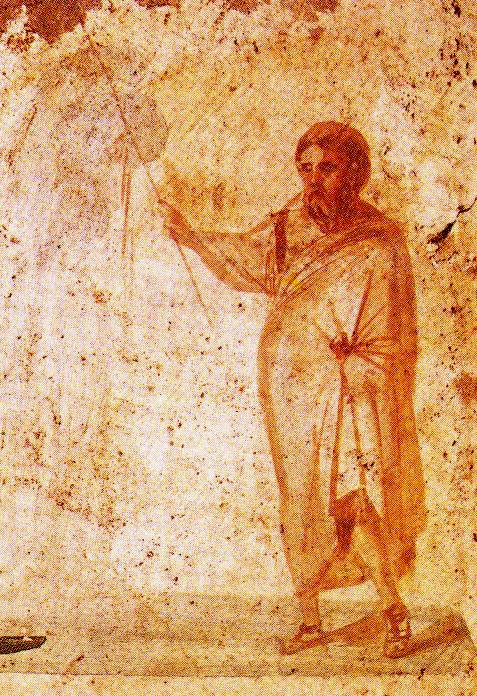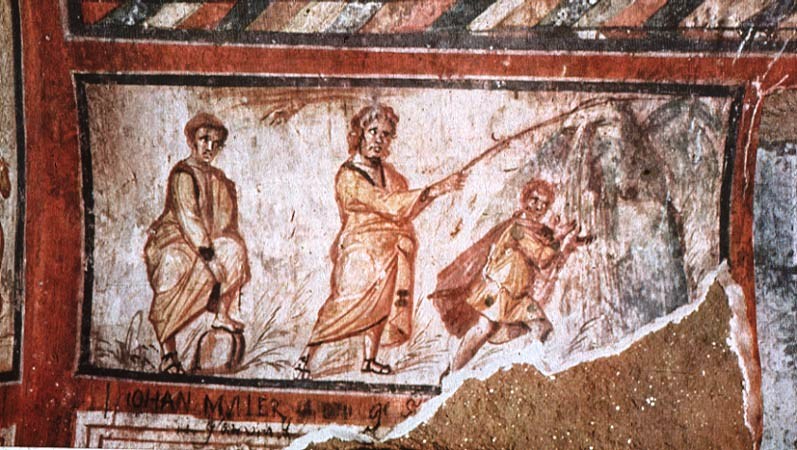
 |
Freethought & Rationalism ArchiveThe archives are read only. |
|
|||||||
|
|
Thread Tools | Search this Thread |
|
|
#11 |
|
Veteran Member
Join Date: Jun 2010
Location: seattle, wa
Posts: 9,337
|
Moses-Peter parallel from Clementine Recognitions 2:30:
In like manner, also, during the last period of His teaching, He (Jesus) wages war against the scribes and Pharisees, charging them with evil deeds and unsound doctrine, and with hiding the key of knowledge which they had handed down to them from Moses, by which the gate of the heavenly kingdom might be opened. |
|
|
|
|
#12 |
|
Veteran Member
Join Date: Jun 2010
Location: seattle, wa
Posts: 9,337
|
Recognitions 3:56:
In a similar transaction I see that I am even now engaged. For as then, when Moses exhorted the king to believe God, the magicians opposed him by a pretended exhibition of similar signs, and so kept back the unbelievers from salvation; so also now, when I have come forth to teach all nations to believe in the true God, Simon the magician resists me, acting in opposition to me, as they also did in opposition to Moses; in order that whosoever they be from among the nations that do not use sound judgment, they may be made manifest; but that those may be saved who rightly distinguish signs from signs." While Peter thus spoke, Niceta answered: "I beseech you that you would permit me to state whatever occurs to my mind." Then Peter, being delighted with the eagerness of his disciples, said: "Speak what you will." Then said Niceta: "In what respect did the Egyptians sin in not believing Moses, since the magicians wrought like signs, even although they were done rather in appearance than in truth? For if I had been there then, should I not have thought, from the fact that the magicians did like things to those which Moses did, either that Moses was a magician, or that the magicians wrought their signs by divine commission? For I should not have thought it likely that the same things could be effected by magicians, even in appearance, which he who was sent by God performed. And now, in what respect do they sin who believe Simon, since they see him do so great marvels? Or is it not marvellous to fly through the air, to be so mixed with fire as to become one body with it, to make statues walk, brazen dogs bark, and other such like things, which assuredly are sufficiently wonderful to those who know not how to distinguish? Yea, he has also been seen to make bread of stones. But if he sins who believes those who do signs, how shall it appear that he also does not sin who has believed our Lord for His signs and works of power? " 3:61 "The ten pairs34 of which we have spoken have therefore been assigned to this world from the beginning of time. Cain and Abel were one pair. The second was the giants and Noah; the third, Pharaoh and Abraham; the fourth, the Philistines and Isaac; the fifth, Esau and Jacob; the sixth, the magicians and Moses the lawgiver; the seventh, the tempter and the Son of man; the eighth, Simon and I, Peter; the ninth, all nations, and he who shall be sent to sow the word among the nations; the tenth, Antichrist and Christ. Concerning these pairs we shall give you fuller information at another time." When Peter spoke thus, Aquila said: "Truly there is need of constant teaching, that one may learn what is true about everything." |
|
|
|
|
#13 |
|
Veteran Member
Join Date: Jun 2010
Location: seattle, wa
Posts: 9,337
|
Moses is the prophet and Peter is like him in the Clementine Literature:
UPDATE (Oct 21): A relevant article on the fourth-century Recognitions version of the Pseudo-Clementines has appeared. Nicole Kelley argues, among other things, that the author of the Recognitions attempts to establish the authority and ultimate knowledge of Peter (via the True Prophet, Jesus) over against other claims to knowledge (especially astrology’s claims of true knowledge with respect to “fate”, but also claims of knowledge among competing forms of Christianity). And she places this assertion of Peter’s access to true knowledge within the context of religious rivalries in fourth century Syria (among Jewish Christians and followers of Marcion, Bardaisan, and others). The romance (story of Clement’s family) in particular functions in this manner: The old astrologer’s claim that “fate” determined the dissolution of Clement’s family is countered successfully by Peter’ knowledge that God’s providence, not fate, was at work. And the reunion of Clement’s family proves Peter (and the source of his knowledge, the True Prophet) right. See Nicole Kelley, “Problems of Knowledge and Authority in the Pseudo-Clementine Romance of Recognitions,” Journal of Early Christian Studies 13 (2005) 315-348 (online institutional subscription required). |
|
|
|
|
#14 |
|
Veteran Member
Join Date: Jun 2010
Location: seattle, wa
Posts: 9,337
|
Moses gets water from the rock
 
|
|
|
|
|
#15 |
|
Veteran Member
Join Date: Jun 2010
Location: seattle, wa
Posts: 9,337
|
Peter getting water from the rock:
 Since the most repeated miracle story in the Bible is the story most commonly shown on sarcophagi, it may come as a surprise that the second most common sarcophagus scene does not appear in the Bible at all. Nor is it ever mentioned by early church fathers in extant writings. However, it does appear in the apocryphal book, Acts of Saints Processus and Martinianus. In it Peter strikes a rock and produces water, echoing Moses in Exodus 17:6, and then baptizes his jailers. Roman Christian tradition holds that this event took place in the Mamertine Prison (Tullianum), on the Capitoline Hill in Rome. The prominence of this image and its absence in the Bible suggest to us that Christianity in Rome was far less catholic than what was reported by the church fathers including Ignatius, Irenaeus, Origen, and even Eusebius. Peter is again the subject of the fourth most common sarcophagus image - the related scene of his capture and arrest, again not present in the canon. Joseph Wilpert concluded that the images of Peter's arrest were derived from the story of his arrest by Herod Agrippa (Acts 12:3-19)[2]. This seems highly unlikely, given that Peter's water miracle is absent from Acts, the Roman dress of his jailers, and the tradition of Peter in Rome. Furthermore, none of Peter's miracles that actually do appear in Acts ever appear on sarcophagi. Some of Peter's miracles from Acts would make impressive carvings, such as his resurrection of Tabitha or his miraculous murder of Ananias and Sapphira. The table below lists the scenes by number of occurrences. Of the scenes listed above, 196, or just under 50%, include Jesus. Seventy three (17%) depict Peter, who always uses a wand to perform his miracles. http://www.rome101.com/Topics/Christian/Magician/ |
|
|
|
|
#16 |
|
Veteran Member
Join Date: Jun 2010
Location: seattle, wa
Posts: 9,337
|
Because early Christian art regularly paralleled Peter with Moses (especially in Rome), Paul naturally came to be aligned with Aaron.18 In the late fourth century, Gaudentius of Brescia (ca. 390) emphasized the analogous, fraternal relationships, citing the line of Psalm 133:1, “Behold how good and pleasant it is when brothers dwell in unity.” 19 Gaudentius even called them “twins,” born from one womb, and “blood brothers,” siblings by a communion of blood. http://books.google.com/books?id=L9L...%2C%22&f=false
|
|
|
|
|
#17 |
|
Veteran Member
Join Date: Jun 2010
Location: seattle, wa
Posts: 9,337
|
More from above:
Another possible model is the imperial Tetrachs, represented with their arms around one another in sculptural groups from Venice to Rome. The motif, usually referred to as the concordia apostolorum, shows them embracing (like the tetrarchs), presumably at their first Roman reunion. An early (fourth-century) version of this motif was discovered in the recent excavations of the catacomb of the “ex-vigna Chiaraviglio, ” near the Basilica of San Sebastiano, possibly associated with the memoria to the apostles at that site. Two palm trees, standing on either side of the apostles, attest to their coming martyrdom as they lock arms in greeting.15 Another early example of this theme, on an early fifth-century ivory belt buckle discovered beneath the cathedral of Castellammare di Stabia (30 km southeast of Naples), shows the two leaning in toward one another, their cheeks touching and their arms entwined.16 This particular composition may have been influenced by a painting in Rome's fourth-century basilica of San Paolo fuori le Mura (destroyed by fire in 1823). Here, Paul and Peter's meeting was the final fresco on the north wall, ending a series of forty episodes on the life of Paul and concluding a biblical cycle that made brotherhood one of its unifying themes by depicting Cain and Abel, Isaac and Ishmael, Jacob and Esau, Joseph and his brothers, and Moses and Aaron.17 One of the scenes of Moses and Aaron portrayed the two brothers embracing – perhaps an intentional allusion to the concordia apostolorum. |
|
|
| Thread Tools | Search this Thread |
|